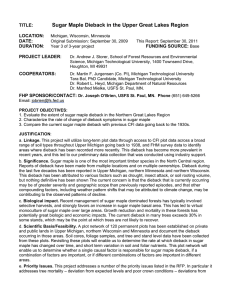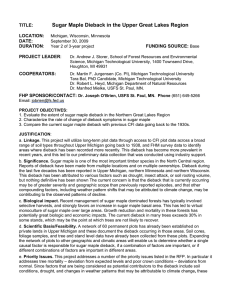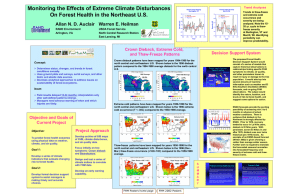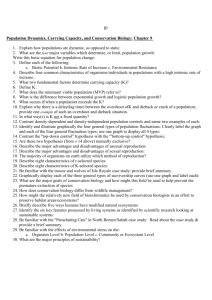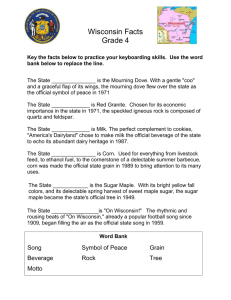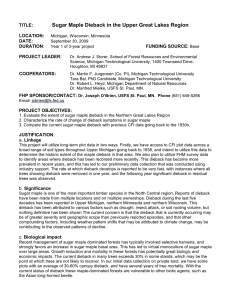Assessment of Sugar Maple Dieback Across the Upper Great Lakes Region
advertisement
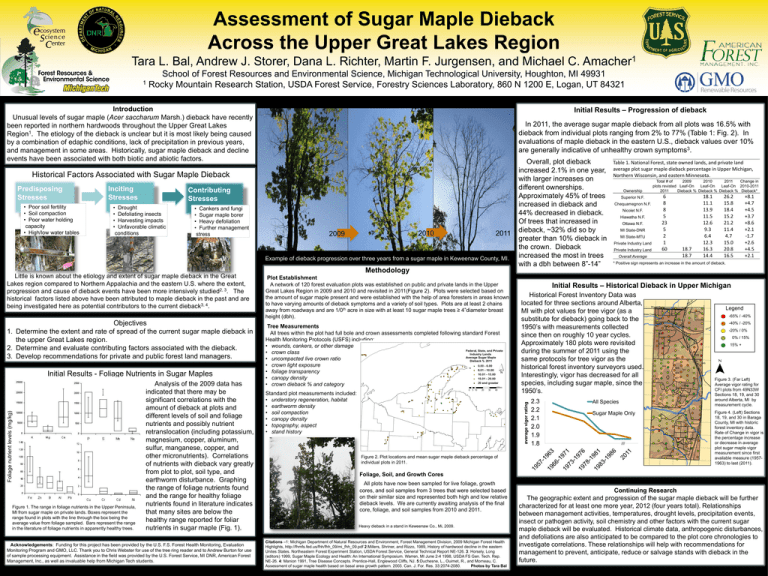
Assessment of Sugar Maple Dieback Across the Upper Great Lakes Region Tara L. Bal, Andrew J. Storer, Dana L. Richter, Martin F. Jurgensen, and Michael C. 1 Amacher School of Forest Resources and Environmental Science, Michigan Technological University, Houghton, MI 49931 1 Rocky Mountain Research Station, USDA Forest Service, Forestry Sciences Laboratory, 860 N 1200 E, Logan, UT 84321 Introduction Unusual levels of sugar maple (Acer saccharum Marsh.) dieback have recently been reported in northern hardwoods throughout the Upper Great Lakes Region1. The etiology of the dieback is unclear but it is most likely being caused by a combination of edaphic conditions, lack of precipitation in previous years, and management in some areas. Historically, sugar maple dieback and decline events have been associated with both biotic and abiotic factors. Initial Results – Progression of dieback In 2011, the average sugar maple dieback from all plots was 16.5% with dieback from individual plots ranging from 2% to 77% (Table 1: Fig. 2). In evaluations of maple dieback in the eastern U.S., dieback values over 10% are generally indicative of unhealthy crown symptoms3. Historical Factors Associated with Sugar Maple Dieback Predisposing Stresses • Poor soil fertility • Soil compaction • Poor water holding capacity • High/low water tables Inciting Stresses Contributing Stresses • Drought • Defoliating insects • Harvesting impacts • Unfavorable climatic conditions • Cankers and fungi • Sugar maple borer • Heavy defoliation • Further management stress 2010 2009 2011 Example of dieback progression over three years from a sugar maple in Keweenaw County, MI. Objectives 1. Determine the extent and rate of spread of the current sugar maple dieback in the upper Great Lakes region. 2. Determine and evaluate contributing factors associated with the dieback. 3. Develop recommendations for private and public forest land managers. Foliage nutrient levels (mg/kg) Initial Results - Foliage Nutrients in Sugar Maples Figure 1. The range in foliage nutrients in the Upper Peninsula, MI from sugar maple on private lands. Boxes represent the range found in plots with the line through the box being the average value from foliage sampled. Bars represent the range in the literature of foliage nutrients in apparently healthy trees. Analysis of the 2009 data has indicated that there may be significant correlations with the amount of dieback at plots and different levels of soil and foliage nutrients and possibly nutrient retranslocation (including potassium, magnesium, copper, aluminum, sulfur, manganese, copper, and other micronutrients). Correlations of nutrients with dieback vary greatly from plot to plot, soil type, and earthworm disturbance. Graphing the range of foliage nutrients found and the range for healthy foliage nutrients found in literature indicates that many sites are below the healthy range reported for foliar nutrients in sugar maple (Fig. 1). Acknowledgements: Funding for this project has been provided by the U.S. F.S. Forest Health Monitoring, Evaluation Monitoring Program and GMO, LLC. Thank you to Chris Webster for use of the tree ring reader and to Andrew Burton for use of sample processing equipment. Assistance in the field was provided by the U.S. Forest Service, MI DNR, American Forest Management, Inc., as well as invaluable help from Michigan Tech students. Plot Establishment A network of 120 forest evaluation plots was established on public and private lands in the Upper Great Lakes Region in 2009 and 2010 and revisited in 2011(Figure 2). Plots were selected based on the amount of sugar maple present and were established with the help of area foresters in areas known to have varying amounts of dieback symptoms and a variety of soil types. Plots are at least 2 chains away from roadways and are 1/0th acre in size with at least 10 sugar maple trees ≥ 4”diameter breast height (dbh). Tree Measurements All trees within the plot had full bole and crown assessments completed following standard Forest Health Monitoring Protocols (USFS) including: • wounds, cankers, or other damage • crown class • uncompacted live crown ratio • crown light exposure • foliage transparency • canopy density • crown dieback % and category Standard plot measurements included: • understory regeneration, habitat • earthworm density • soil compaction • canopy density • topography, aspect • stand history Figure 2. Plot locations and mean sugar maple dieback percentage of individual plots in 2011. Table 1. National Forest, state owned lands, and private land average plot sugar maple dieback percentage in Upper Michigan, Northern Wisconsin, and eastern Minnesota. Ownership Superior N.F. Chequamegnon N.F. Nicolet N.F. Hiawatha N.F. Ottawa N.F. MI State-DNR MI State-MTU Private Industry Land Private Industry Land Overall Average Total # of 2009 2010 2011 Change in Leaf-On Leaf-On 2010-2011 plots revisted Leaf-On 2011 Dieback % Dieback % Dieback % Dieback* 6 8 8 5 23 5 2 1 60 18.7 18.7 18.1 11.1 13.9 11.5 12.6 9.3 6.4 12.3 16.3 14.4 26.2 15.8 18.4 15.2 21.2 11.4 4.7 15.0 20.8 16.5 +8.1 +4.7 +4.5 +3.7 +8.6 +2.1 -1.7 +2.6 +4.5 +2.1 * Positive sign represents an increase in the amount of dieback. Initial Results – Historical Dieback in Upper Michigan Historical Forest Inventory Data was located for three sections around Alberta, MI with plot values for tree vigor (as a substitute for dieback) going back to the 1950’s with measurements collected since then on roughly 10 year cycles. Approximately 180 plots were revisited during the summer of 2011 using the same protocols for tree vigor as the historical forest inventory surveyors used. Interestingly, vigor has decreased for all species, including sugar maple, since the 1950’s. average vigor rating Little is known about the etiology and extent of sugar maple dieback in the Great Lakes region compared to Northern Appalachia and the eastern U.S. where the extent, progression and cause of dieback events have been more intensively studied2, 3. The historical factors listed above have been attributed to maple dieback in the past and are being investigated here as potential contributors to the current dieback3, 4. Methodology Overall, plot dieback increased 2.1% in one year, with larger increases on different ownerships. Approximately 45% of trees increased in dieback and 44% decreased in dieback. Of trees that increased in dieback, ~32% did so by greater than 10% dieback in the crown. Dieback increased the most in trees with a dbh between 8”-14” 2.3 2.2 2.1 2.0 1.9 1.8 All Species Sugar Maple Only /// Legend -65% / -40% -40% / -20% -20% / 0% 0% / 15% 15% + Figure 3. (Far Left) Average vigor rating for CFI plots from 49N33W Sections 18, 19, and 30 around Alberta, MI by measurement cycle. Figure 4. (Left) Sections 18, 19, and 30 in Baraga County, MI with historic forest inventory data. Rate of Change in vigor is the percentage increase or decrease in average plot sugar maple vigor measurement since first available measure (19571963) to last (2011). Foliage, Soil, and Growth Cores All plots have now been sampled for live foliage, growth cores, and soil samples from 3 trees that were selected based on their similar size and represented both high and low relative dieback levels. We are currently awaiting analysis of the final core, foliage, and soil samples from 2010 and 2011. Heavy dieback in a stand in Keweenaw Co., Mi, 2009. Citations –1: Michigan Department of Natural Resources and Environment, Forest Management Division, 2009 Michigan Forest Health Highlights, http://fhmfs.fed.us/fhh/fhh_09/mi_fhh_09.pdf 2:Millers, Shriner, and Rizzo, 1989, History of hardwood decline in the eastern Unites States. Northeastern Forest Experiment Station, USDA Forest Service, General Technical Report NE-126. 3: Horsely, Long (editors) 1999, Sugar Maple Ecology and Health: An International Symposium. Warren, MI June 2-4 1998, USDA FS Gen. Tech. Rep. NE-26. 4: Manion 1991, Tree Disease Concepts. Prentice-Hall, Englewood Cliffs, NJ. 5:Duchesne, L., Ouimet, R., and Morneau, C. Assessment of sugar maple health based on basal area growth pattern. 2003. Can. J. For. Res. 33:2074-2080. Photos by Tara Bal Continuing Research The geographic extent and progression of the sugar maple dieback will be further characterized for at least one more year, 2012 (four years total). Relationships between management activities, temperatures, drought levels, precipitation events, insect or pathogen activity, soil chemistry and other factors with the current sugar maple dieback will be evaluated. Historical climate data, anthropogenic disturbances, and defoliations are also anticipated to be compared to the plot core chronologies to investigate correlations. These relationships will help with recommendations for management to prevent, anticipate, reduce or salvage stands with dieback in the future.
